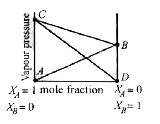In the mixtures of two miscible volatile liquids obeying Raoults' law, the correct behaviour is explained by

AB stands for the vapour pressure of component B in presence of solute A
CD stands for the vapour pressure of solvent A in presence of solute B
BC stands for the total vapour pressure in accordance with the Dalton's law of partial pressures
all of the above.
The correct Answer is:D
all of the above.
Related Playlists
- BOOK - MTG GUIDECHAPTER - SOLUTIONS EXERCISE - CHECK YOUR NEET VITALS25videos
SOLUTIONS
- BOOK - MTG GUIDECHAPTER - SOLUTIONS EXERCISE - AIPMT/NEET MCQs23videos
SOLUTIONS
- BOOK - MTG GUIDECHAPTER - SOLUTIONS EXERCISE - AIPMT/NEET MCQs23videos
SOLUTIONS
- BOOK - MTG GUIDECHAPTER - SOLID STATE EXERCISE - AIPMT/NEET MCQS17videos
SOLID STATE
- BOOK - MTG GUIDECHAPTER - SURFACE CHEMISTRYEXERCISE - AIMPT/NEET MCQS11videos
SURFACE CHEMISTRY
Similar Practice Problems
- Question 1 - Select One
A solution that obeys Raoult’s law is:
ANormalBMolarCIdealDSaturated - Question 1 - Select One
A solution which obeys Raoult's law is
ANormalBMolarCIdealDSaturated - Question 1 - Select One
A mixture of liquid showing positive deviation in Raoult’s law is
A(CH3)2O+C2H5OHB(CH3)2O+CHCl3C(C2H5)2O+CHCl3D(CH3)2O+C6H5NH2 - Question 1 - Select One
Based on the given diagram, which of the following statements regarding the solutions of two miscible volatile liquids are correct?
1. Plots AD and BC show that Raoult's law is obeyed for the solution in which B is a solvent and A is the solute and as well as for that in which A is solvent and B is solute.
2. Plots CD shows that Dalton's law of partial pressures is observed by the binary solutions of components A and B.
EF+EG=EH,and AC and BD corresponds to the vapour pressures of the pure solvents A and B, respectively.
Select the correct answer using the codes given below:
 A1 and 2B2 and 3C1 and 3D1,2, and 3
A1 and 2B2 and 3C1 and 3D1,2, and 3 - Question 1 - Select One
How will you separate a mixture of two miscible liquids benzene and chloroform ?
AsublimationBFiltrationCFractional distillationDCrystallisation
Similar Questions
A solution that obeys Raoult’s law is:
View SolutionA mixture of two miscible liquids can be separated by separating funnel.
View SolutionHow will you separate a mixture of two miscible liquids benzene and chloroform ?
View SolutionIn an ideal solution of two liquids, each component obey Raoult's law.
View SolutionA solution of two volatile liquids A and B obeys Raoult's law. At a certain temperature it is found that when the pressure above the mixture in equilibrium is 402.5 mm of Hg, the mole fraction of A in the vapour is 0.35 and in the liquid it is 0.65. What are the vapour pressures of two liquids at this temperature ?
View Solution

